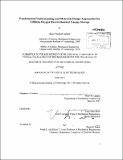| dc.contributor.advisor | Yang Shao-Horn. | en_US |
| dc.contributor.author | Gallant, Betar M. (Betar Maurkah) | en_US |
| dc.contributor.other | Massachusetts Institute of Technology. Department of Mechanical Engineering. | en_US |
| dc.date.accessioned | 2013-10-24T17:45:31Z | |
| dc.date.available | 2013-10-24T17:45:31Z | |
| dc.date.copyright | 2013 | en_US |
| dc.date.issued | 2013 | en_US |
| dc.identifier.uri | http://hdl.handle.net/1721.1/81698 | |
| dc.description | Thesis (Ph. D.)--Massachusetts Institute of Technology, Dept. of Mechanical Engineering, 2013. | en_US |
| dc.description | Cataloged from PDF version of thesis. | en_US |
| dc.description | Includes bibliographical references (p. 177-182). | en_US |
| dc.description.abstract | New strategies and materials are needed to increase the energy and power capabilities of lithium storage devices for electric vehicle and grid-scale applications. Systems based on oxygen electrochemistry are promising due to the relatively high potentials (~ 3 V vs. Li) of Li-oxygen redox couples, which can enable high energy to be stored in the absence of heavy and expensive transition metal-based compounds used in conventional Li-ion battery electrodes. This thesis explores two strategies to incorporate Li-oxygen redox electrochemistry into electrodes for high-power or high-energy devices: (1) oxygen functionalization of carbon surfaces for fast surface Li storage, and (2) bulk oxygen reduction and Li storage in Li-air batteries with a theoretical cell-level gravimetric energy up to 4 times higher than Li-ion batteries. First, we study the charge storage mechanisms in oxygen-functionalized multiwalled carbon nanotube (MWNT) positive electrodes for high-power Li batteries. Thin-film (below 3 im) electrodes are used as a platform for probing the kinetics of surface redox reactions between Li+ and oxygen on MWNTs in asymmetric and symmetric cell configurations. We next extend this concept to the development of freestanding electrodes with more practical thicknesses (tens of pm). By varying the MWNT functionalization time, we show that the surface oxygen concentration can be controlled to yield electrodes with tunable energy and power characteristics, with typical gravimetric energies of ~200 Wh/kgelectode at ~10 kW/kgeectrode. The second part of this thesis investigates fundamental and design considerations to enable development of Li-air battery electrodes with high gravimetric energy, improved round-trip efficiency, and increased stability upon cycling. Using aligned carbon nanofiber (CNF) or nanotube (CNT) electrodes synthesized in-house, we report the first observations of Li₂O₂ particle formation and shape evolution during discharge. Highly porous (> 90% void volume) CNF electrodes achieve one of the highest gravimetric energies (2400 Wh/kgdischarged at 30 W/kgdischarged) to date, demonstrating the role of electrode structure in realizing the theoretical energy advantage of Li-air systems at the laboratory scale. We next use CNT electrodes as a platform for studying chemical and morphological changes occurring in the electrode during cycling, and find that poor cycle life can be attributed to gradual accumulation of parasitic Li₂CO₃ promoted by reactivity of the carbon substrate. Finally, we study the influence of Li₂O₂ discharge rate-dependent structure and surface chemistry on the oxidation kinetics to probe the fundamental origins of high overpotentials required on charge. An integrated morphological, chemical, and electrochemical approach highlights new considerations for the design of practical electrodes for increased round-trip efficiency and improved cycle life. | en_US |
| dc.description.statementofresponsibility | by Betar Maurkah Gallant. | en_US |
| dc.format.extent | 182 p. | en_US |
| dc.language.iso | eng | en_US |
| dc.publisher | Massachusetts Institute of Technology | en_US |
| dc.rights | M.I.T. theses are protected by
copyright. They may be viewed from this source for any purpose, but
reproduction or distribution in any format is prohibited without written
permission. See provided URL for inquiries about permission. | en_US |
| dc.rights.uri | http://dspace.mit.edu/handle/1721.1/7582 | en_US |
| dc.subject | Mechanical Engineering. | en_US |
| dc.title | Fundamental understanding and materials design approaches for lithium-oxygen electrochemical energy storage | en_US |
| dc.type | Thesis | en_US |
| dc.description.degree | Ph.D. | en_US |
| dc.contributor.department | Massachusetts Institute of Technology. Department of Mechanical Engineering | |
| dc.identifier.oclc | 860901230 | en_US |
